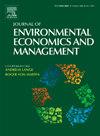Optimal climate policy under exogenous and endogenous technical change: Making sense of the different approaches
IF 5.9
3区 经济学
Q1 BUSINESS
Journal of Environmental Economics and Management
Pub Date : 2025-08-05
DOI:10.1016/j.jeem.2025.103216
引用次数: 0
Abstract
We analyse the large and diverse literature on technical change in integrated assessment models (IAMs) of climate change, with a view to understanding how different representations of technical change affect optimal climate policy. We first solve an analytical IAM that features several models of technical change from the literature, including exogenous technical change in abatement technologies, exogenous decarbonisation of the economy, endogenous technical change via learning-by-doing, and endogenous technical change via R&D (in particular, directed technical change). We show how these models of technical change impact optimal carbon prices, emissions and temperatures in often quite different ways. We then survey how technical change is currently represented in the main quantitative IAMs used to inform policy, demonstrating that a range of approaches are used. Exogenous technical change in abatement technologies and learning-by-doing are most popular, although the latter mechanism is only partially endogenous in some models. We go on to quantify technical change in these policy models using structural estimation, and simulate our analytical IAM numerically, assessing the effect of technical change on optimal climate policy. We find large quantitative effects of technical change and large quantitative differences between different representations of technical change, both under cost-benefit and cost-effectiveness objectives.
外生和内生技术变化下的最优气候政策:不同方法的理解
我们分析了气候变化综合评估模型(iam)中关于技术变化的大量不同文献,以期了解技术变化的不同表示如何影响最佳气候政策。我们首先解决了一个分析性IAM,该IAM以文献中的几个技术变革模型为特征,包括减排技术的外源性技术变革、经济的外源性脱碳、通过实践学习的内源性技术变革以及通过研发(特别是定向技术变革)的内源性技术变革。我们展示了这些技术变革模型如何以不同的方式影响最优碳价格、排放和温度。然后,我们调查了目前用于通知政策的主要定量iam中如何表示技术变化,展示了使用的一系列方法。减排技术中的外生技术变化和边做边学是最受欢迎的,尽管后一种机制在某些模型中只是部分内生的。我们继续使用结构估计来量化这些政策模型中的技术变化,并在数值上模拟我们的分析IAM,评估技术变化对最优气候政策的影响。我们发现,在成本效益和成本效益目标下,技术变革的数量效应很大,不同技术变革表现形式之间的数量差异也很大。
本文章由计算机程序翻译,如有差异,请以英文原文为准。
求助全文
约1分钟内获得全文
求助全文
来源期刊
CiteScore
8.00
自引率
4.30%
发文量
91
期刊介绍:
The Journal of Environmental Economics and Management publishes theoretical and empirical papers devoted to specific natural resources and environmental issues. For consideration, papers should (1) contain a substantial element embodying the linkage between economic systems and environmental and natural resources systems or (2) be of substantial importance in understanding the management and/or social control of the economy in its relations with the natural environment. Although the general orientation of the journal is toward economics, interdisciplinary papers by researchers in other fields of interest to resource and environmental economists will be welcomed.

 求助内容:
求助内容: 应助结果提醒方式:
应助结果提醒方式:


